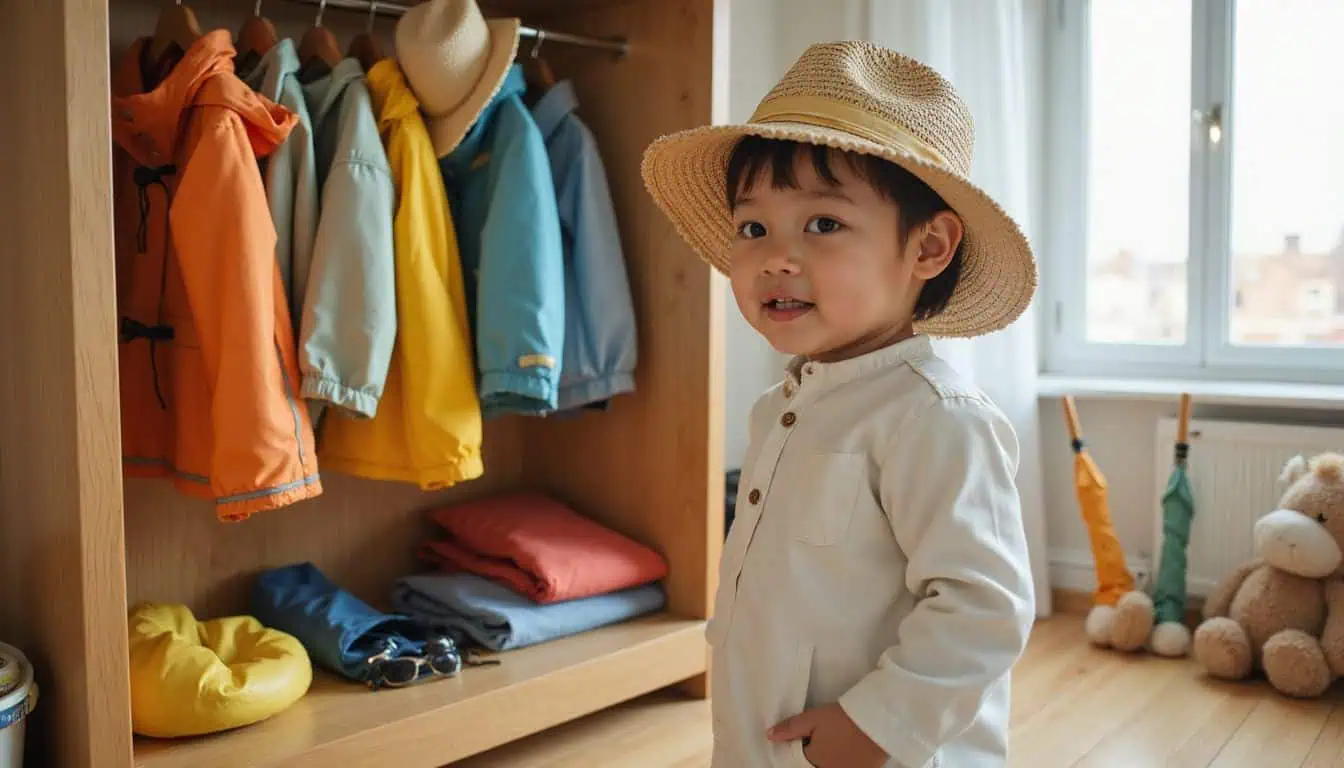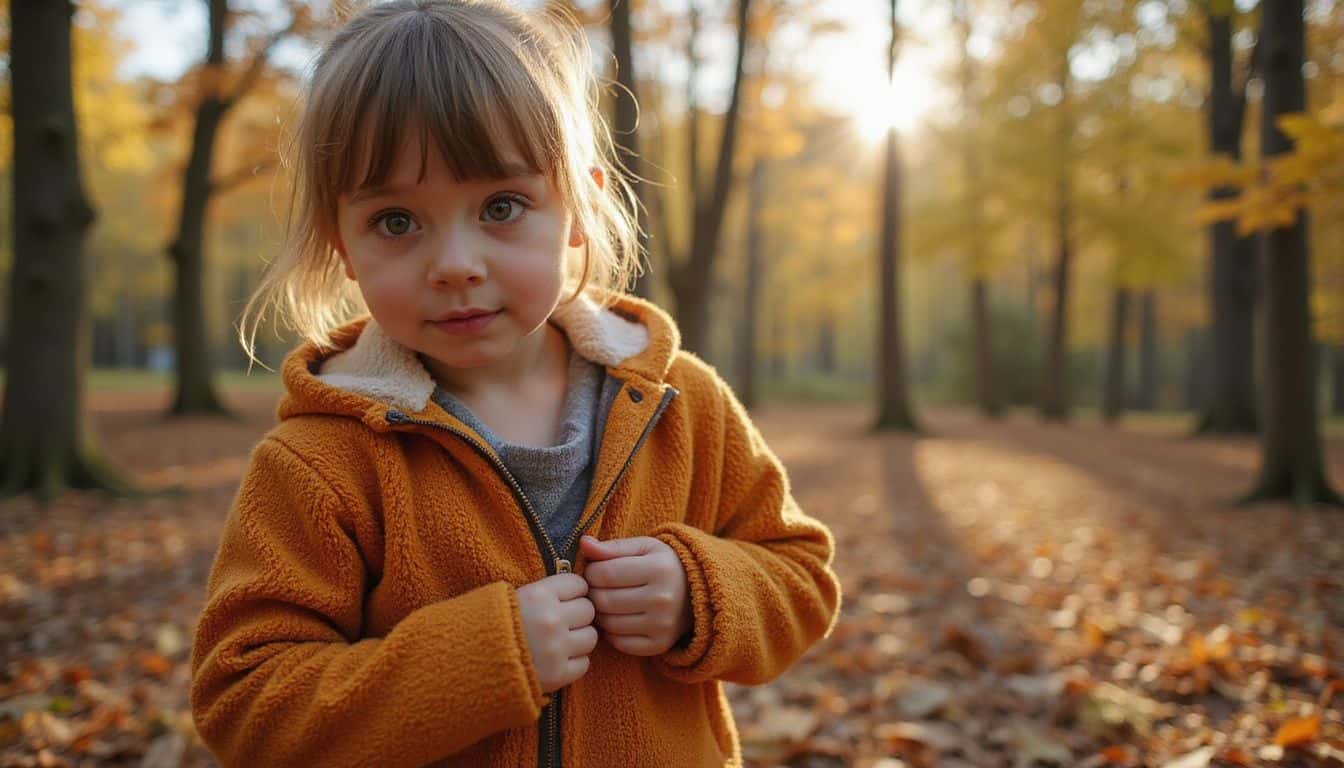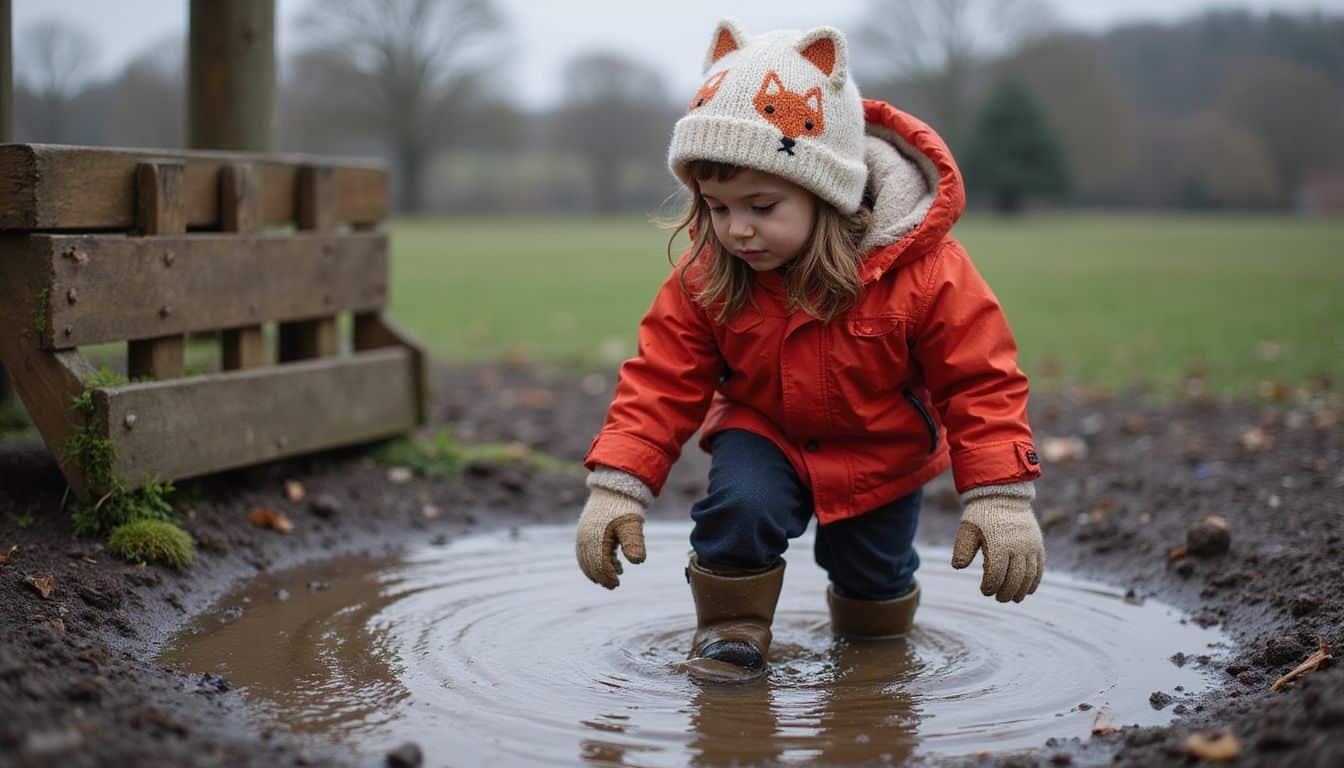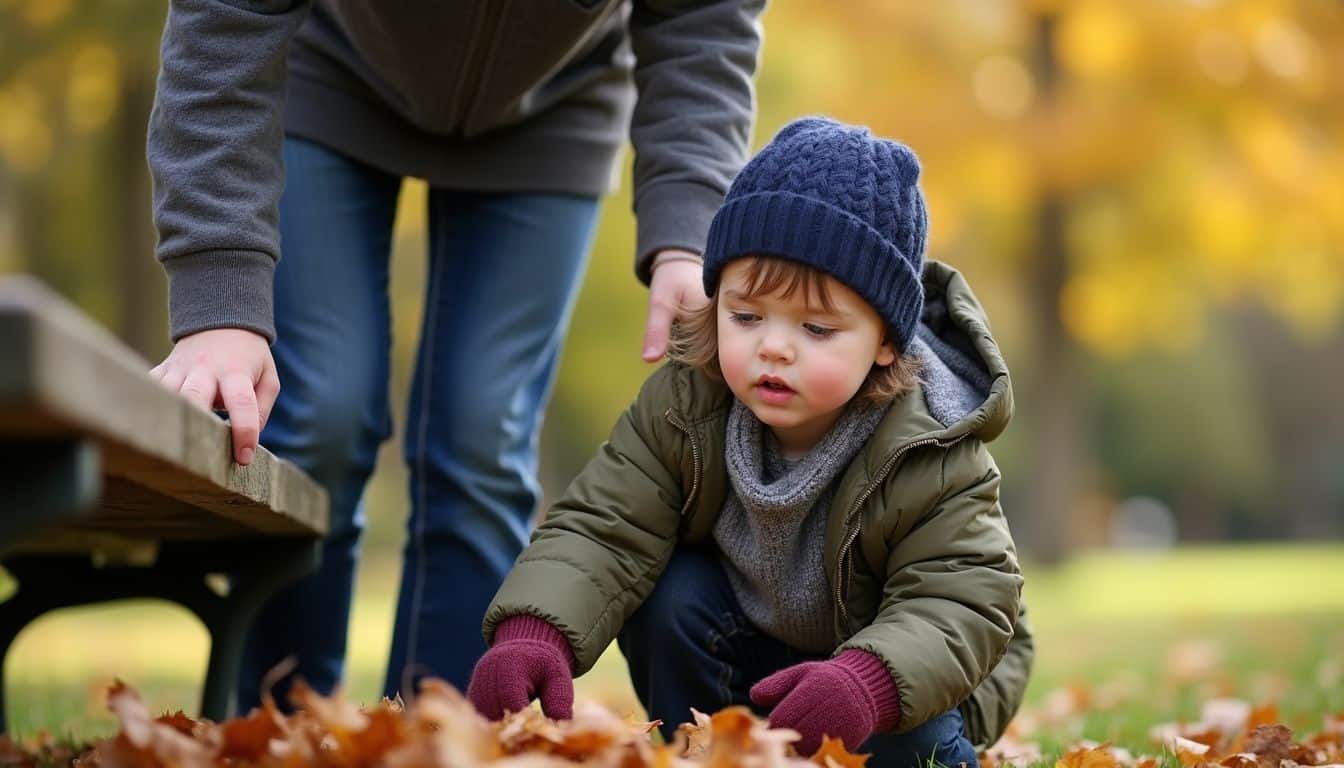Getting your kids ready for outdoor play can feel overwhelming, especially when the weather keeps changing. Proper layering helps children stay comfortable and safe during all their outdoor adventures.
This guide on how to dress kids for outdoor play will give you six practical tips that make dressing your little ones simple and stress-free. Your kids will love playing outside in any weather.
Key Takeaways
Choose weather-appropriate clothing with synthetic or merino wool base layers, fleece mid-layers, and waterproof outer shells for comfort.
Layer clothing using three-layer system: moisture-wicking base layer, insulating middle layer, and waterproof windproof outer layer for protection.
Select synthetic fabrics or merino wool over cotton for active play since they dry faster and maintain warmth.
Protect kids with sturdy closed-toe shoes, waterproof boots for wet conditions, and UV-protective hats and sunglasses outdoors.
Sustainable eco-friendly materials and multifunctional versatile clothing will dominate children’s outdoor wear trends in 2025.
Table of Contents
Dress Kids According to Weather

Weather changes fast, and kids need clothes that match each condition. Smart parents pick different outfits for sunny days, cold mornings, and rainy afternoons to keep their little ones comfortable and safe.
What Should Kids Wear in Warm Weather?
Hot weather demands smart clothing choices for kids’ outdoor play. Proper warm-weather outfits keep children cool, protected, and comfortable during summer activities.
- Choose synthetic or merino wool underwear as your child’s base layer to wick moisture away from skin and prevent overheating during active play.
- Dress kids in short sleeve t shirts made from breathable fabrics that allow air circulation and quick drying.
- Pick quick-dry hiking pants or lightweight shorts that move with your child’s body and resist stains from outdoor adventures.
- Select clothing with UPF ratings to shield delicate skin from harmful sun rays during extended outdoor time.
- Dress infants and toddlers in lightweight cotton or cotton-like fabrics since they tolerate shorter periods of outdoor play than older children.
- Avoid heavy materials like thick fleece or dark colors that trap heat and cause discomfort in warm temperatures.
- Pack extra clothes in your bag since kids get messy and sweaty during summer play sessions.
- Choose loose-fitting garments that don’t restrict movement while climbing, running, or playing sports outside.
- Apply sunscreen to exposed skin areas that clothing doesn’t cover, especially face, arms, and legs.
How to Dress Kids for Cold Weather?
Cold weather demands smart clothing choices to keep your little ones warm and comfortable during outdoor adventures. A three-layer system works best for protecting kids from harsh winter conditions.
- Start with a tight-fitting base layer made of merino wool or synthetic materials. This foundation wicks moisture away from skin and maintains body heat even when wet.
- Add a fleece jacket or insulated mid layer for warmth. This layer traps warm air close to the body and provides essential insulation during cold days.
- Top with a waterproof outer layer that blocks wind and moisture. Snow pants and a quality rain jacket protect against snow, sleet, and freezing rain.
- Cover heads with warm hats that protect ears completely. Kids lose significant body heat through their heads, making proper headwear essential for comfort.
- Choose waterproof mittens over gloves for better finger warmth. Mittens keep fingers together, creating more heat than individual glove compartments.
- Select snow boots rated for winter temperatures your area experiences. Proper footwear prevents frostbite and provides traction on icy surfaces.
- Add one extra layer for toddlers compared to older children. Younger kids have less body mass and need additional insulation to stay warm.
- Check hands regularly to monitor your child’s temperature. Cold hands signal the need for warmer clothing or time to head indoors.
Proper fabric choices make all the difference in keeping kids comfortable during winter play.
What Clothing Protects Kids in Wet Weather?
Cold weather gear keeps kids warm, but wet weather demands different protection strategies. Rain and moisture require specialized clothing that blocks water while allowing comfort during active play.
- A good rain jacket is essential for keeping kids dry during wet weather play, featuring waterproof materials and sealed seams that prevent moisture from seeping through.
- Waterproof footwear, such as gumboots, is critical for ensuring dry feet and comfort in wet conditions, protecting against puddles and muddy terrain.
- Rain ponchos offer excellent coverage for kids who need quick protection, covering both body and backpack while allowing easy movement during outdoor activities.
- Synthetic fabrics work better than cotton for wet weather apparel because they dry faster and maintain insulation properties even when damp.
- Woolen socks are preferred over cotton as they provide better insulation and keep feet warm even if moisture gets inside boots.
- Waterproof pants protect legs from rain and wet grass, especially important for kids who love rolling and playing on damp ground.
- Protecting backpacks with waterproof covers is important to keep gear and clothes dry, ensuring spare items stay usable throughout the day.
- Nylon rainwear provides excellent breathability while blocking water, preventing kids from overheating during active play sessions.
- Proper raincoat selection includes features like adjustable hoods, reflective strips, and ventilation zippers for maximum protection and comfort.
Why Is Layering Important for Kids’ Outdoor Clothing?

Layering keeps kids comfortable during outdoor play by trapping warm air between clothes and letting you adjust their temperature as weather changes. This smart approach prevents overheating during active play and keeps little ones cozy when they slow down, making outdoor adventures more enjoyable for everyone.
What Is the Best Base Layer for Kids?
Quality base layers come in two main types: Merino wool and synthetic materials. Merino wool offers warmth even when wet, resists odors, and regulates temperature naturally. Synthetic fabrics dry quickly and work well for high-energy activities like running or climbing.
Both options provide excellent moisture-wicking properties that keep kids comfortable during outdoor play.
Base layers should fit snugly against your child’s skin to enhance moisture-wicking and prevent cold air from entering. A proper fit allows the fabric to pull sweat away from the body effectively.
Loose base layers create gaps where cold air can sneak in, making kids feel chilly. You can find great activewear options at stores like Patagonia or browse rei.com for quality merchandise.
Check out ideas for 12th birthday party if you’re planning outdoor celebrations that require proper layering.
The right base layer acts like a second skin, keeping children dry and comfortable no matter how active they get outdoors.
The middle layer plays a crucial role in trapping warm air close to your child’s body.
How Does the Middle Layer Keep Kids Warm?
The middle layer serves as your child’s personal heating system during outdoor adventures. This crucial layer retains body heat for insulation, creating a warm pocket of air around your little one’s body.
Materials like thick knit wool, polyester fleece, or down insulation work best for this purpose. My daughter learned this lesson the hard way during a forest school session last winter, she wore only a thin cotton shirt under her jacket and came home shivering despite the sunny weather.
Fleece jackets stand out as top recommendations for insulation because they trap warm air effectively. These garments maintain their insulating properties even when slightly damp from active play.
The goal of layering focuses on three key functions: retaining heat, wicking away moisture, and keeping rain, snow, and wind out. Fleece materials excel at all three tasks, making them perfect for energetic kids who work up a sweat while climbing trees or building snow forts.
Your child’s emotional development benefits too, as staying comfortable means more time exploring and less time complaining about being cold. The outer layer completes this protective system by shielding against harsh weather elements.
Why Use an Outer Layer That Is Waterproof and Windproof?
An outer layer protects against wind, rain, and snow during outdoor adventures. Kids need this shield to stay comfortable while they play outside. Waterproof or water-resistant materials keep moisture from soaking through to their clothes underneath.
Wind can make children feel much colder than the actual temperature, so windproof jackets help them stay warm.
Breathability is essential to prevent overheating during physical activities like running or climbing. Your child’s outer jacket should let sweat escape while keeping bad weather out.
This balance helps kids play longer without getting too hot or too cold. A suitable outer layer enhances comfort in various weather conditions, whether your little ones are building snowmen or splashing in puddles.
Smart parents often find great deals on quality outer layers at thrift stores during Black Friday sales.
Now let’s look at which fabrics work best for your child’s outdoor clothing.
Which Fabrics Are Best for Kids’ Outdoor Clothes?

Picking the right fabric for your kids’ outdoor clothes can make or break their playtime comfort… and trust me, there’s way more to this than just grabbing whatever looks cute off the rack.
When Is Cotton Suitable for Kids’ Clothing?
Cotton works perfectly for casual outings with your little ones. This lightweight, breathable fabric keeps kids comfortable on dry summer days while staying budget-friendly for growing children.
My daughter loves wearing her cotton t-shirts during playground visits, park picnics, and neighborhood walks. The soft material feels gentle against sensitive skin, making it ideal for toddlers who wear diapers underneath their clothes.
Cotton falls short during active adventures or bad weather conditions. The fabric absorbs moisture quickly but dries slowly, leaving kids damp and uncomfortable during intense play sessions.
Skip cotton for hiking trips where your children might work up a sweat, or rainy days when they need better protection. Instead, save those cotton sneakers and casual clothes for calm, sunny afternoons when the weather stays predictable and your kids plan gentler activities.
How Does Wool Help Keep Kids Warm and Dry?
Cotton works well for mild days, but wool offers superior warmth for colder outdoor adventures. Merino wool is soft against children’s skin and provides excellent insulation even when temperatures drop.
This natural fiber retains heat effectively, keeping kids warm during extended outdoor play sessions. Wool’s unique structure traps air between its fibers, creating a barrier that maintains body temperature.
Wool is nature’s own insulation system, designed to keep little adventurers comfortable in challenging weather.
Wool has antibacterial properties, which can reduce odor buildup during active play. Parents appreciate this feature since kids often work up a sweat while running, climbing, and exploring.
Merino wool feels comfortable against skin and doesn’t cause the itchiness that traditional wool sometimes creates. While wool is less effective at wicking moisture compared to other materials, it still keeps children comfortable by regulating their body temperature naturally.
Why Choose Synthetic Fabrics for Kids’ Playwear?
Synthetic fabrics work great for kids’ playwear because they dry fast and last long. These materials cost less than wool, making them budget-friendly for growing children. Kids can run, jump, and play hard without parents worrying about expensive clothing getting ruined.
Synthetic fabrics pull moisture away from skin, keeping children comfortable during active play.
These fabrics might feel a bit clammy during high-aerobic activities, but they bounce back quickly from rough play. Parents love how easy synthetic materials are to wash and care for.
The quick-drying feature means kids can get back outside faster after muddy adventures. Synthetic playwear handles everything from playground games to backyard exploration with ease.
What Accessories Protect Kids During Outdoor Play?

Smart accessories make the difference between a fun outdoor adventure and a miserable experience for kids. The right gear protects children from harsh weather, keeps them comfortable, and lets them focus on playing instead of feeling cold, wet, or uncomfortable.
Which Hats, Gloves, and Scarves Work Best in Cold Weather?
Cold weather accessories protect your child’s head, hands, and neck from freezing temperatures. Selecting appropriate materials and styles keeps kids comfortable during winter outdoor play.
- Fleece hats provide excellent warmth and are commonly used for winter headwear. They dry quickly and maintain insulation even when slightly damp.
- Wool mittens offer superior warmth compared to gloves because fingers share body heat. Natural wool fibers trap air and create effective insulation for small hands.
- Synthetic scarves made from nylon or polyester materials resist moisture and wind. These waterproof options protect necks from snow and sleet during active play.
- Earmuffs come in various styles for different age groups, from toddlers to teens. Adjustable headbands ensure proper fit and comfort for growing children.
- Knit handwear with adjustable elements like velcro straps stays secure during playground activities. Wrist closures that prevent snow from entering gloves are beneficial.
- Balaclava masks cover the entire head and neck area for extreme cold conditions. These full-coverage options work well for skiing or sledding adventures.
- Waterproof gloves with grip patterns help kids hold onto playground equipment safely. Textured palms prevent slipping on wet or icy surfaces.
- Thermal neck gaiters pull up easily over the nose and mouth when winds pick up. Kids can adjust coverage quickly without removing other winter gear.
Sun-protection accessories shield children from harmful rays during warmer outdoor activities.
How to Protect Kids from the Sun with Accessories?
Cold weather gear keeps kids warm, but summer brings different challenges. Sun protection becomes your top priority during outdoor play sessions.
- Choose wide-brimmed hats or caps that shade your child’s face, neck, and ears completely. These essential accessories block harmful UV rays better than baseball caps alone.
- Invest in UV-protective sunglasses designed specifically for children’s smaller faces. Quality sunglasses shield delicate eye areas from sun damage during active play.
- Apply sunscreen generously to all exposed skin areas before heading outside. This crucial step safeguards kids’ skin from harmful UV rays that accessories can’t cover.
- Follow CDC guidelines by dressing kids in long sleeves and pants for maximum sun coverage. Light-colored, loose-fitting clothes work best in hot weather conditions.
- Combine multiple sun protection methods for complete coverage during outdoor activities. Hats, sunglasses, and protective clothing work together more effectively than single items.
- Select accessories with high ultraviolet protection factor ratings for serious sun defense. Check labels carefully to ensure maximum protection levels for your active children.
- Pack extra hats and sunglasses in your outdoor gear bag for replacement needs. Kids lose accessories frequently during energetic play sessions outside.
- Choose adjustable straps on sunglasses and hats to keep them secure during movement. Proper fit prevents accessories from falling off during active games.
How to Choose Proper Footwear for Kids?
Good shoes protect your child’s feet during outdoor adventures. The right footwear keeps kids safe, comfortable, and ready for any weather they might face while playing outside.
Why Are Sturdy, Closed-Toe Shoes Important?
Sturdy, closed-toe shoes provide better protection against injuries like stubbed toes and cuts from sharp objects. Kids face many hazards during outdoor play, from rocks and sticks to playground equipment.
Proper footwear acts as a shield, keeping little feet safe from harm. These shoes are essential for outdoor activities, ensuring safety during play while kids run, jump, and explore.
Closed-toe shoes help prevent blisters and future foot problems with proper fit. They also minimize the risk of slips and falls when paired with slip-resistant soles. Quality hiking shoes offer the support growing feet need during active play.
Parents should choose footwear that covers the entire foot, leaving no toes exposed to potential dangers lurking on playgrounds, trails, or in backyards.
When Should Kids Wear Waterproof Boots?
Kids need waterproof boots during rainy weather to keep their feet dry and comfortable. Rain creates puddles, streams, and soggy ground that regular shoes can’t handle. Your child’s feet will stay warm and protected when they wear proper rain boots.
These boots work best for outdoor adventures during wet conditions.
Parents should encourage outdoor activities like splashing in puddles to promote the use of rain boots. Kids love jumping in water, and waterproof footwear makes this safe and fun.
Check the boots regularly for wear and tear, replacing them as needed to maintain protection. Proper sizing stays crucial, so measure your children’s feet often to ensure a good fit.
Snowsuits pair well with waterproof boots during winter months when snow and slush cover the ground.
How Will Kids’ Outdoor Clothing Choices Change in 2025?
Sustainable and eco-friendly materials will become more prominent in children’s activewear as environmental awareness increases. Parents will find more recycled materials in outdoor clothing options, making it easier to select gear that protects both their children and the planet.
Improvements in fabric technology will provide better performance while maintaining sustainability goals. Snow suits and other winter gear will incorporate these new materials, offering excellent warmth without compromising environmental values.
Multifunctional and versatile clothing items will become more important in 2025. Manufacturers will produce pieces that adapt to different weather conditions, reducing the need for multiple outfits.
These smart designs will help parents save money while ensuring their children stay comfortable during outdoor activities. Fabric improvements will make clothing lighter, more durable, and easier to care for, giving busy families practical solutions for active play.
People Also Ask
What should parents consider when dressing kids for outdoor play?
Parents should focus on weather conditions, activity level, and comfort. Choose clothes that allow free movement while protecting against sun, wind, or cold temperatures.
How many layers should children wear during outdoor activities?
Layer clothing based on the season and temperature. Start with a moisture-wicking base layer, add insulation if needed, then finish with a weather-resistant outer shell.
What type of footwear works best for kids playing outside?
Sturdy, closed-toe shoes with good grip prevent slips and protect feet from rocks or debris. Avoid sandals or flip-flops during active play sessions.
Should parents pack extra clothes for outdoor adventures?
Yes, always bring backup clothing. Kids get dirty, wet, or sweaty during play, so having fresh clothes ensures comfort and prevents illness from staying in damp garments.
References
https://www.rei.com/learn/expert-advice/how-to-dress-your-kids-for-the-outdoors.html
https://everydayoutdoorfamily.com/how-to-dress-kids-for-winter/
https://lifehacker.com/how-to-dress-your-kids-to-play-outside-all-winter-1845844732
https://www.wildlingsforestschool.com/blog/how-to-dress-kids-for-wet-weather-play-1
https://talesofamountainmama.com/kids-base-layers/ (2024-09-14)
https://www.weareoutgrown.org/resources/56895/layering-your-kiddos-based-on-temperature
https://getthekidsoutside.com/dress-kids-for-weather/
https://backwoodsmama.com/2017/12/keeping-kids-warm-in-the-winter-with-base-layers.html
https://www.chicagotribune.com/2021/02/02/winter-accessories-for-kids/
https://www.omegapediatrics.com/summer-footwear-safety-tips-for-children/ (2024-05-24)
